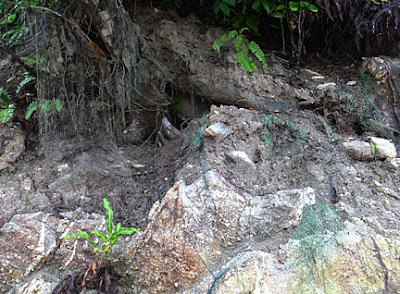We were at Labrador to monitor seagrasses there as part of TeamSeagrass. We explored the shore as we waited for the tide to fall.
The pink-spotted Bead anemone (Anthopleura buddemeieri) is a rather quirky anemone that is found very high on a natural rocky shore. Unfortunately, in Singapore such habitats are rare, and thus the anemone is not often encountered. In fact, I only found one of these anemones on our trip today. The rocky shore is very much alive with other creatures, mainly molluscs and snails of all kinds! Marcus and Andy saw lots of other creatures too.
There are many fast moving Sea slaters (Ligia sp.) on the shore. Although they are sometimes called Sea cockroaches, they are not true insects and are crustacea like crabs and shrimps! Among them are some true insects of the shore. These are Shore crickets (Family Gryllidae)! My first time paying attention to them on Labrador!
I took the opportunity to take a closer look at some common seaweeds. This pretty lacy seaweed is tiny! Each 'frond' is less than 0.5cm. They coat the rocks near the high water mark on natural rocky shores like Labrador and Sentosa. I haven't quite figured out what it is yet.
Coin seaweeds (Halimeda sp.) looks like a series of coins joined together. Each coin-like segment is hard as it is impregnated with calcium carbonate. The portions between the segments are not calcified, so the bunch of segments is rather flexible. The calcium carbonate released from dead Halimeda seaweeds are said to make major contributions to sand in some areas such as the Bahamas and the Great Barrier Reef!
Here's a closer look at Neomeris sp. The seaweed is actually made up of tiny branches packed tightly around a central stalk to form the cylindrical shape, somewhat like the bristles on a bottlebrush. The base to middle portion of the 'stem' is white and calcified while the upper ends are bright green, and often fuzzy at the tips. The green tiny branches at the tip are younger.
Pom pom red seaweed is a ball-shaped cluster of many thin, cylindrical 'stems' that are densely branched. The 'stems' are hard and thus the seaweed feels crunchy when stepped upon (try to NOT to step on them). Colours range from pinkish and lilac to deep magenta and purple. This one seems to have a pale rounded 'cap' at the tip of the 'stem'.
In the rain, the water gushing down onto the shore through a pipe was more obvious.
The water flowing through the pipe seems quite clear and it obviously comes from the natural hillside as there were lots of forest flowers in the water flow.
There is a large sandy strip under the water outfall. I'm not sure how the water flow affects seagrasses growing on the shore. Possibly there are good effects as nutrient flows from the forest are probably natural.
There were several dead corals washed up on the shore. I notice this often also at Sentosa.
I saw a large dead coral washed up quite high on the shore.
Alas, we also came across some nets that washed ashore. This bunch was entangled in a branch.
The net sure looked much larger after we wrestled it free. The volume of the pile was 38cm x 30cm x 12cm.
The net seems rather new. There were two kinds of fibres in this net. A woven fibre with a mesh size of about 13cm, and a monofilament plastic kind with a mesh size of about 4cm. This data will go toward the Project Driftnet effort.
There were also bits of nets stuck high up on plants growing on the natural cliffs.
There was also another net badly entangled among the roots of a fallen tree.
But the rest of the shore was quite clean of floating plastic and debris.
Alas, the tide today did not fall as low as predicted. We were expecting a 0.2m tide but seems we got a 0.3 or 0.4m tide instead. I've been told that in wet weather, there are barometric effects that mess up the tidal predictions.
The water was also rather murky. Not surprising, given the constant rain throughout the day and during our trip. We saw a flood of brown water near the mainland on our way home from Cyrene yesterday.
The only seagrasses I saw were bits washed up on the shore. Hopefully this means there's still some seagrasses in deeper water.
We had to abandon the effort to monitor the seagrasses as the tide wasn't obliging. For years, next to Labrador, there has been massive reclamation, dredging and other coastal works for the new Pasir Panjang Container Terminal which includes underwater blasting. Monitoring the seagrasses at Labrador will help give an indication of the health of the shore.
Thanks to Marcus and Andy for coming today all prepared to monitor and hauling out the nets, and to Yuet Hsin and Ben for supporting our effort. I'm so sorry we couldn't get the primary job done. Hopefully the tides will be kinder to us in the future.
Others who posted about this trip
- Marcus Ng with more rocky shore sightings.





















